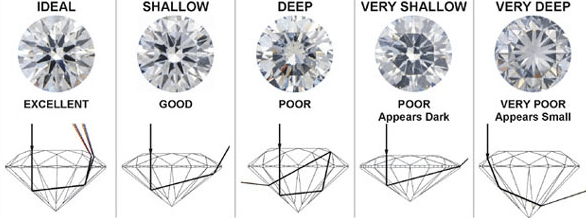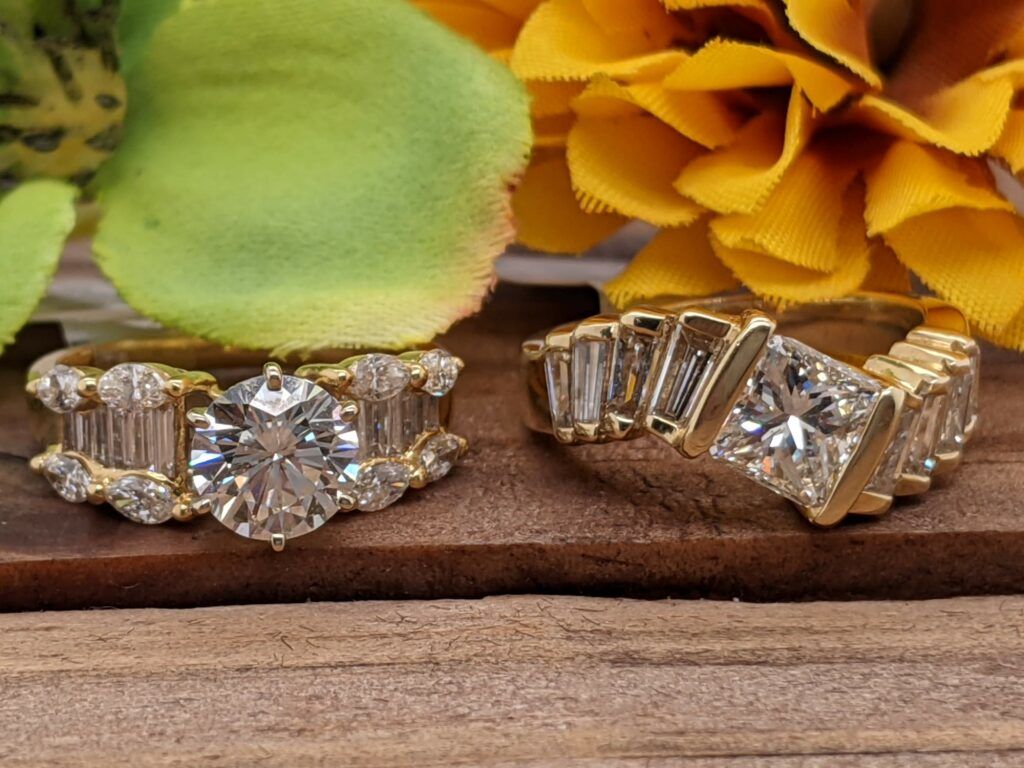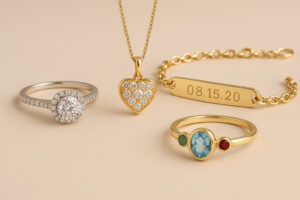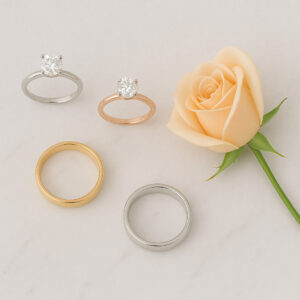Do you ever walk into a jewelry store, stand there and think; I know what I want, but am I going to get the best quality for my budget? Not all jewelry stores are as honest as we are. We will only sell you a diamond that we, ourselves, would buy. Plus, we will only sell you high quality pieces that will make you look & feel wonderful! That’s why we buy jewelry in the first place, right? We want to buy the best for our loved ones, or even ourselves. We want to feel amazing and special when we look at ourselves. If you are a little confused about picking out the right diamond, here are some important things you should know before buying one. THE 4 C’s!
First "C": The Cut


A Cut of the Diamond references to two different aspects. The first is the Shape of the diamond. The most brilliant shape is the Round cut diamond. But, in the photo above you can see other common cuts. The second part of the cut is the ratio of the diamond. When the cut on a diamond is IDEAL (not too deep and not too shallow) the light goes through the top, bounces around the bottom and shines back up through the top. Round and princess cut diamonds are the only 2 cuts that can be cut to Ideal proportions. An Ideal cut diamond reflects almost all the light that enters the stone. That is why the diamond is so sparkly and catches the light. When the cut is too shallow (wide and short), the light goes through the top and out the side making the diamond appear dark and dull. When the cut is too deep (narrow and tall), the light goes through the top and bounces out the side/bottom. This makes the diamond appear smaller than it actually is. An Ideal cut can make all the difference between a perfect eye catching diamond and just having a diamond.
Second "C": The Color

The color of a diamond relates to its whiteness. Color is graded from the side of the diamond. GIA certified diamonds are graded loose (not set in a ring). The classification is like the alphabet, except the diamond alphabet starts with the letter D. D is the whitest a diamond can get. D, E, or F, are considered colorless which means that they are the most sought after, and more expensive due to their rarity. Diamonds that are G, H, I, or J, are near colorless. As you continue down the alphabet you will begin to see a faint yellow color. Diamonds that are N-Z are yellow to brown. These Diamonds are great, if you want a Beautiful Yellow Gold ring with a yellow stone. The Color Scale only grades the whiteness of the diamond. If you have a colored diamond it will not have a color grade related. It will be a classified as a Fancy color (Mined), High Pressured & High Temperature (treated) or an irradiated diamond (Treated). The Colored diamonds allow you to have the Hardness of a diamond and the shine of a diamond but the color of a different stone.
Third "C": The Clarity

The clarity of the diamond is a grade based on the inclusions that are inside the diamond. Some examples of inclusions are: a “Bruise” which is a tiny impact that creates small root-like lines, a “Pinpoint” which is minute crystal enclosed in the diamond that looks like tiny specs and a “Cloud” which is a group of tiny pinpoints that make the diamond look “cloudy”.
The Clarity is graded with 10x power magnification. The diamond grader looks at the number of inclusions, the size of the inclusions and their location in a diamond. The ratings are abbreviated using these abbreviations V=Very S= Slight I=Inclusions. The best grade is FL (IF) which stands for internally flawless. Flawless diamonds are rare and cost a pretty penny. This means that there are no imperfections in the diamond that can be found under a 10X magnification. The Next grade is VVS1 & VVS2. With this grade one or two pinpoints or smaller inclusions can be found under magnification. To the naked eye these will not even register. If you have a 10x Power magnification you still need to have a trained eye or even map of the inclusions to find them. A VS1 & VS2 graded diamond will have more imperfections. You might be able to find them along the edges or outer area of the diamond under magnification. SI1 & SI2 are the lowest clarity of diamond that you still need magnification to see the imperfections. I1 & I2 have inclusions that you can see to the naked eye. “I” rated stones with black imperfections are also called salt and pepper diamonds. These diamonds definitely have a characteristic and are unique is their own way.
Here at Hendrickson’s, we recommend the VS1-SI2 clarity for any engagement ring. This is because to the naked eye they look amazing and under magnification you can tell it is your diamond.
Fourth "C": Carat

The Last “C” is Carat. The Carat is the weight and size of the diamond. In the good old days they use to use Carob seeds to weigh out stones. It was believed that all Carob seeds weighed the exact same at 200 milligrams. That is how the name carat came along. A one carat diamond weighs the same as one carob seed. Just like a US dollar is made out of 100 pennies, one carat is made out of 100 Points. With an Ideal cut, the chart above will show you the approximate millimeter size the stone should be. The carat weight of a diamond has the biggest effect on how much it cost. A higher carat weight means the diamond is rarer (or heavier) and also more expensive. There are different carat weights where the price per carat drastically changes. Opting for a .94 carat weight which is similar in size to a 1.00 carat, can cost a lot less. The same goes for jumping up in .25, .50 & .75 weights.
A great hint for making the carat weight work for you is using Halos and cluster diamonds. If you have a smaller stone (less than a carat) you can incorporate a Halo. A halo is a ring of smaller diamonds surrounding the stone. This adds brilliances and volume to the ring. It also makes the stone appear larger then it is. We don’t recommend halos for large diamonds because it tends to take away from the diamond at that point. The second hint is cluster diamonds. If you take 7 smaller similar sized diamonds and arrange in a circle with one in the center you get a cluster top. The cluster is the size of a 1-2 carat stone but only have a weight of .50-1.00ct diamonds. With clusters you also get the shine of seven diamonds catching the light instead of just one.
Buying Something here at Hendrickson’s Fine Jewelry Doesn’t just make you a Customer it also makes you family, and Family always takes care of family!
Our mailing address is:
5685 N. Glenwood
Boise, ID 83714
TEXT OR CALL US AT:
208-853-1615
Additional Informations
American Gem Society “What Are the 4 Cs of Diamonds”
GIA “4Cs of Diamond Quality: What’s the Most Important C?”




